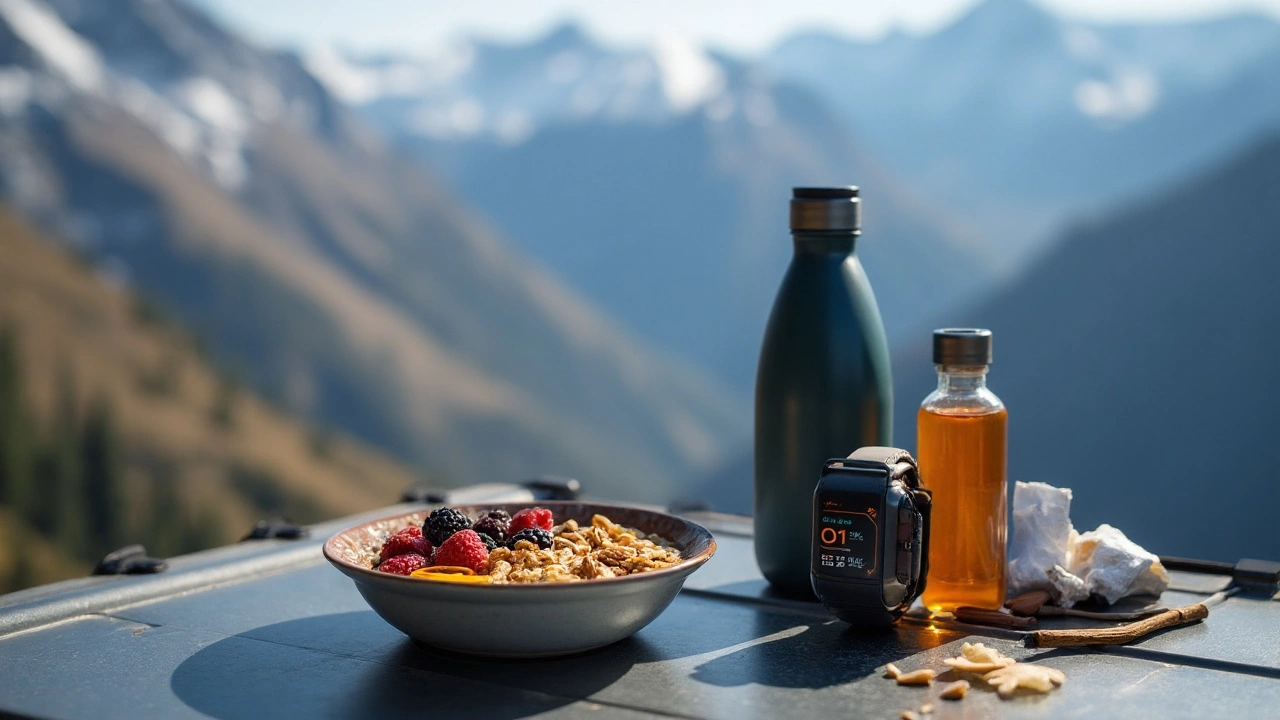TL;DR: Acclimatize gradually, boost aerobic fitness, use intermittent hypoxic training, stay hydrated, monitor oxygen saturation, and supplement iron if needed.
What Is Mountain Sickness?
Acute Mountain Sickness is a clinical syndrome caused by rapid exposure to low barometric pressure and hypoxia at high elevations, typically presenting with headache, nausea, and fatigue. It affects up to 30% of trekkers who ascend above 2,500m without proper preparation (data from high‑altitude research societies).
Understanding the underlying physiology is the first step toward training your body to tolerate it.
Key Physiological Drivers
Three major systems decide how well you cope:
- Acclimatization is the process whereby the body adapts to reduced oxygen availability, raising red blood cell count, hemoglobin concentration, and ventilation rate. It typically begins within 6‑12hours of exposure.
- VO₂ Max measures the maximal amount of oxygen your body can use during intense exercise. Higher VO₂ Max values correlate with better oxygen delivery at altitude.
- Hemoglobin carries oxygen in the bloodstream. Each gram increase can improve arterial oxygen saturation by roughly 1‑2% at 4,000m.
Targeting these variables through specific training regimes can dramatically lower AMS risk.
Training Strategies to Boost Acclimatization
Below are evidence‑backed methods that athletes, hikers, and rescue teams use.
1. Aerobic Base Building
Develop a solid aerobic foundation (3‑5sessions per week, 45‑90min at 60‑70% of HRmax). Studies from the Alpine Club show a 15% reduction in AMS incidence after a 6‑week base phase.
2. Intermittent Hypoxic Training (IHT)
Intermittent Hypoxic Training is a protocol that simulates altitude by delivering low‑oxygen air (12‑14% FiO₂) for short bouts, followed by normoxic recovery. Typical session: 5minutes hypoxia×6cycles, 3times per week.
IHT triggers erythropoietin release without the logistical challenges of traveling to high terrain.
3. Real Altitude Exposure (Live‑High/Train‑Low)
Sleeping at 2,500‑3,000m while training at lower elevations maintains training intensity. This “live‑high/train‑low” model improves both erythropoiesis and VO₂ Max.
4. Breath‑Holding and Diaphragmatic Exercises
Practicing controlled breath‑holds (3‑4×30seconds) strengthens the diaphragm and boosts ventilatory efficiency, a useful adjunct for high‑altitude trekking.
| Attribute | Intermittent Hypoxic Training | Real Altitude Exposure |
|---|---|---|
| Equipment Needed | Hypoxic mask or chamber | Access to altitude lodging |
| Time Commitment | 30‑45min per session, 3×/week | ≥12hours nightly sleep |
| Erythropoietin Boost | Moderate (short‑term spikes) | High (sustained) |
| Training Intensity Impact | Minimal interference | Potentially reduced due to hypoxia |
| Cost | Medium (equipment purchase) | High (travel & lodging) |
Nutrition, Hydration, and Supplementation
Fueling the body correctly speeds the acclimatization cascade.
- Iron Supplementation supports hemoglobin synthesis. A daily 18mg dose of elemental iron has been shown to raise hemoglobin by 0.5g/dL in 4weeks for iron‑deficient climbers.
- Carbohydrate‑rich meals (60‑70% of calories) maintain glycogen stores, which are crucial for high‑altitude respiration.
- Stay hydrated: aim for 3‑4L of water per day; dehydration worsens hypoxia‑induced headache.

Monitoring Your Body’s Response
Early detection prevents escalation to severe altitude illnesses such as HAPE or HACE.
- Pulse Oximeter measures peripheral oxygen saturation (SpO₂). Values below 90% at rest signal inadequate acclimatization.
- Use the Lake Louise Score (0‑12) to quantify symptoms; stop ascent if the score exceeds 3.
- Keep a daily journal of sleep quality, heart rate, and headache intensity.
Sample 4‑Week Acclimatization Plan
- Week1: Build aerobic base - 4 runs (45min) at zone2, 2 strength sessions, start daily SpO₂ logging.
- Week2: Introduce IHT - three 30‑minute sessions (5×5‑min hypoxia), continue aerobic runs.
- Week3: Add breath‑holding drills (3×30s) post‑run, begin iron supplementation if ferritin <30µg/L.
- Week4: Simulated night‑altitude - sleep in a hypoxic tent set to 2,500m for 8hours, maintain training intensity.
After the cycle, schedule a low‑key trek to 2,800m and assess symptoms. Adjust the plan based on SpO₂ trends and Lake Louise scores.
Common Pitfalls & Safety Tips
- Skipping gradual ascent - a 300‑m gain per day with a rest day every 3‑4days is the gold standard.
- Ignoring hydration - even mild dehydration doubles the likelihood of AMS.
- Over‑relying on medication - acetazolamide can mask symptoms, leading to delayed treatment of HAPE/HACE.
- Neglecting sleep quality - poor sleep impairs ventilatory acclimatization; consider a sleeping mask to reduce light exposure at altitude.
When severe symptoms (confusion, ataxia, persistent cough) arise, descend immediately and seek medical care.
Frequently Asked Questions
How long does it take to fully acclimatize?
Complete physiological adaptation can take 2‑4weeks at a given altitude, but most trekkers achieve sufficient protection against AMS within 5‑7days if they follow a gradual ascent schedule.
Can I use acetazolamide instead of training?
Acetazolamide (125‑250mg×2) helps prevent AMS, but it does not replace the cardiovascular and hematological benefits of proper training. Use it as a backup, not a substitute.
Is IHT safe for beginners?
Yes, when performed at moderate hypoxic levels (12‑14% FiO₂) and limited to 30‑45minutes per session. Start with one session per week and monitor SpO₂; discontinue if saturation falls below 85%.
What role does iron play in altitude adaptation?
Iron is essential for hemoglobin synthesis. Adequate stores (ferritin>30µg/L) ensure that the erythropoietic response to hypoxia can increase red‑cell mass, improving oxygen transport.
How often should I check my SpO₂ at altitude?
Measure twice daily-once after waking and once before bedtime. A downward trend of more than 2% over 24hours warrants a slower ascent or a rest day.
Can high‑altitude training improve sea‑level performance?
Yes. The “live‑high/train‑low” approach can raise VO₂ Max by 3‑5% and improve endurance performance once the athlete returns to sea level.







Cameron Perry
September 22, 2025 AT 22:09Man, I tried IHT last winter with a cheap hypoxic mask and honestly? It felt like trying to breathe through a sock. But after 3 weeks, my SpO₂ at 10k feet went from 82% to 89%-no joke. Worth the weird face mask vibes.
JOANNA WHITE
September 23, 2025 AT 03:18Just got back from the Rockies 🏔️ and this hit different. I didn't touch iron supplements (my doc said I'm fine) but I drank like 5L of water a day and slept with my window open. My head didn't throb once. Also, breath holds? Try doing them while brushing your teeth. Weirdly helpful 😅
Peggy Cai
September 23, 2025 AT 13:41People think training fixes everything but really you're just fighting nature. You're not a machine. You're meat. And meat doesn't belong above 8k feet. You think your VO2 max matters? It doesn't. The mountain doesn't care if you did 45 minutes at 70% HRmax. It just wants you to surrender. And you should.
Tammy Cooper
September 24, 2025 AT 08:13Okay but who even has time for this? I'm a single mom who works two jobs and somehow I'm supposed to do IHT 3x a week AND sleep at altitude? 😭 I just take ibuprofen and pray. Also I bought a pulse oximeter and now I'm addicted to checking it like it's my ex's Instagram. 88%? Oh god. 89%? I'm a warrior. 87%? I'm dying. Send help.
Alyssa Hammond
September 25, 2025 AT 09:00This whole guide is peak wellness culture nonsense. You're telling me I can 'train' my body to resist a natural physiological response to low oxygen? That's like saying you can 'train' your lungs to not need air. And the table comparing IHT to real altitude? Please. Real altitude is the only thing that matters. Anyone using a mask is just buying into the Silicon Valley alt-physiology scam. Also, iron supplements? Unless you're anemic-which most people aren't-you're just making your pee yellow and stressing your liver. And don't even get me started on 'breath-holding drills.' You're not a freediver, you're a guy who hikes to the top of a mountain to take selfies. Stop pretending this is science. It's just expensive self-help with graphs.
Jill Amanno
September 27, 2025 AT 06:58You know what's wild? None of this matters if you don't have the right mindset. Training your body is easy. Training your mind to accept that you're small, fragile, and temporary in the face of the mountain? That's the real ascent. I used to think I needed to conquer altitude. Now I know I just need to listen to it. The body adapts when you stop forcing it. IHT? Fine. Iron? Maybe. But the real fix is silence. Sitting still. Letting your breath slow. Not chasing the summit. Letting the mountain come to you. That's the only thing that actually saves lives. The rest is just noise.